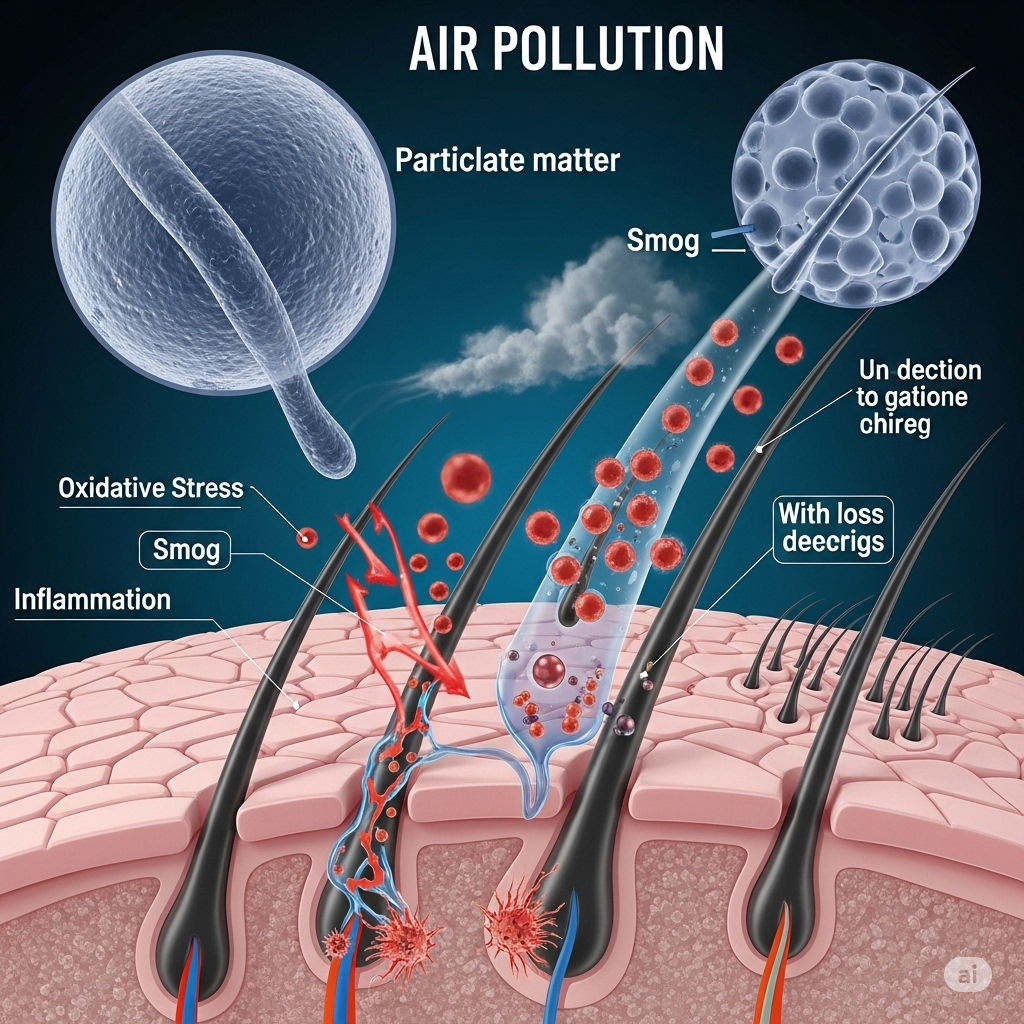Living in an urban environment comes with its perks—convenience, culture, connectivity—but there’s a hidden downside that many people overlook: the air we breathe. As air pollution continues to rise across major cities, it’s not just our lungs and skin paying the price. Our scalp health is also taking a hit, and for those already concerned about thinning hair or hair loss, the effects can be even more profound.
In this article, we’ll explore the link between air pollution and scalp health, how pollutants affect the follicles, and what you can do to protect your scalp and maintain a healthy head of hair—even in the smoggiest environments.
Understanding the Link Between Air Quality and Scalp Health
When people think about air pollution, their first concerns are usually respiratory. But the scalp, being one of the most exposed parts of our body, suffers quietly. It’s easy to ignore, especially since most of us wash our faces and hands more frequently than our hair.
Air pollutants—such as particulate matter (PM10 and PM2.5), nitrogen dioxide, and polycyclic aromatic hydrocarbons (PAHs)—cling to the scalp and hair. These pollutants can clog pores, trigger inflammation, and cause oxidative stress that affects both the scalp and the hair follicles.
Over time, the accumulation of these toxins on the scalp can lead to a range of problems: increased sensitivity, itching, dandruff, excessive oil production, and even hair loss.
The Scalp’s Role in Hair Health
The scalp is not just the surface where hair grows; it’s the foundation of every strand. Healthy hair begins with a healthy scalp. Just like fertile soil is essential for growing strong plants, a nourished, balanced scalp is crucial for strong, vibrant hair.
When the scalp is under attack from pollution, the follicles can become inflamed and damaged. The result? Weaker roots, slower growth, and a shorter lifespan for each hair strand.
How Pollutants Disrupt the Hair Growth Cycle
Hair grows in three main stages: anagen (growth), catagen (transition), and telogen (rest). When air pollutants bombard the scalp, they can disrupt this cycle in several ways:
- Oxidative Stress: Pollutants generate free radicals, which break down essential proteins and lipids on the scalp. This weakens the follicle’s ability to produce healthy hair.
- Inflammation: The presence of toxins can lead to an inflammatory response, making the scalp more sensitive, irritated, or even infected.
- Blocked Follicles: Fine particles and toxic chemicals clog the pores and hair follicles, leading to folliculitis or preventing new hair from emerging.
- Sebum Imbalance: Pollution can cause the scalp to overproduce oil in response to irritation, which further traps dirt and debris, creating a vicious cycle of poor hygiene and poor scalp health.
Early Signs Your Scalp Is Affected
Pollution-induced scalp issues can show up in subtle ways, which are easy to dismiss as temporary or seasonal problems. But if you notice any of the following on a regular basis, your scalp may be reacting to environmental toxins:
- Persistent dandruff or flakiness
- Itchy or sensitive scalp
- Premature oiliness or extreme dryness
- Excessive hair shedding
- Slower hair growth than usual
- Redness or minor breakouts on the scalp
Protecting Your Scalp from Pollution
Start with Scalp-Focused Haircare
Just like you wouldn’t go to sleep without washing your face, your scalp deserves the same end-of-day care. Use a gentle, sulfate-free shampoo formulated specifically for scalp detox. Look for ingredients like activated charcoal, tea tree oil, or salicylic acid that help remove buildup without stripping your scalp of natural oils.
Deep cleansing once or twice a week is ideal, especially for those who live in high-pollution areas.
Antioxidants Are Your Scalp’s Best Friend
Products infused with antioxidants help neutralize free radicals caused by pollution. Vitamin E, niacinamide, green tea extract, and ferulic acid are powerful ingredients that restore the scalp’s natural barrier and promote a healthier environment for hair growth.
A serum or scalp tonic applied directly to the roots can deliver targeted protection.
Wear Physical Barriers When Necessary
You may not think twice about throwing on a scarf or hoodie in cold weather, but covering your head during high-pollution days can act as a physical barrier. If you commute via bike or walk through busy city streets, a hat can reduce direct exposure to harmful airborne particles.
Nutrition That Supports Scalp Resilience
A healthy diet plays a critical role in scalp health. Foods rich in omega-3 fatty acids, zinc, biotin, and antioxidants help strengthen your skin and hair follicles from the inside out. Hydration is just as important—dehydrated skin tends to produce more oil to compensate, which can worsen pollution buildup.
Consider supplements designed to support hair growth and scalp health, especially if your diet lacks essential nutrients.
When to Seek Professional Help
Sometimes, scalp issues caused by pollution can’t be fixed with home remedies alone. If you’ve tried over-the-counter solutions and still experience persistent scalp discomfort or excessive hair shedding, it’s time to consult a professional.
At ZMD Hair, we specialize in diagnosing and treating scalp conditions using advanced techniques and tailored solutions. Whether you need a clinical scalp detox, regenerative treatments like PRP, or a personalized care plan, we help you address the root of the problem—literally.
Conclusion: Don’t Let Pollution Sabotage Your Scalp Health
Air pollution isn’t going away any time soon. But that doesn’t mean your scalp has to suffer. With a proactive routine and the right care, you can protect your scalp from environmental damage, preserve healthy hair growth, and maintain a balanced scalp even in polluted environments.
Your hair is a reflection of your internal and external health. Don’t wait until the damage becomes visible—start protecting your scalp today.
Worried that air pollution is affecting your scalp and hair? Let ZMD Hair help. Book a consultation with our scalp and hair specialists and take the first step toward a healthier, stronger head of hair.




